Are you a Quiet Speculation member?
If not, now is a perfect time to join up! Our powerful tools, breaking-news analysis, and exclusive Discord channel will make sure you stay up to date and ahead of the curve.
I don't get Wizards's decision making. So many calls over the past few years just leave me scratching my head. I'm sure I'm not alone in this, and there have been editorials aplenty on every possible issue already. Instead, today I want to examine one very specific decision and its consequences. Specifically, Wizards made the decision to preprint a card from Modern Horizons 2 in the Strixhaven Mythic Archive. Which in practice means that it was made legal in Historic before any other format. And it is already having an impact, in ways which are suggestive of how Modern will react.
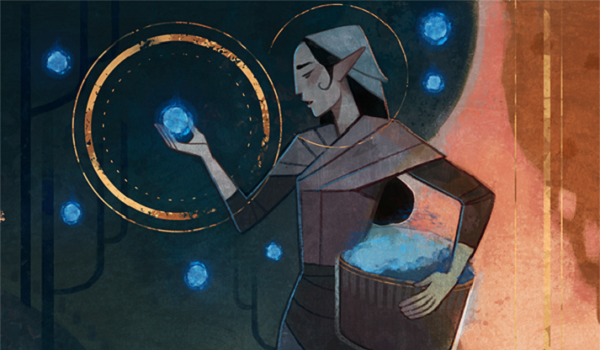
Before I continue, I should note that I am no expert on Historic. I don't play Arena much because the economy is... poor, to be diplomatic. Subsequently, I have very limited experience evaluating Historic decks. That won't matter because I'm just using them as a jumping-off point to investigate Modern applications. However, in addition to this standard disclaimer, I'm going to make the following plea: does anyone get Historic? Specifically, what is it supposed to be? It made sense as Pioneer-light initially, but now it's become this weird mishmash of Pioneer and Legacy and I don't understand where Wizards is going with Historic. Is it an experiment in creating a format? Do they intend to replace Legacy with Historic? Do they even have a plan? If you know or at least have a decent explanation, let me know.
Abundant Harvest
Preprinting Abundant Harvest is the strangest thing Wizards has done in some time. With everything else controversial, there's been decent arguments for it being good or bad. This time, though, it's just bizarre. Reactions to the revelation were primarily "huh, that's weird." As time's gone on, discussion has moved more towards the power of the card, but with the 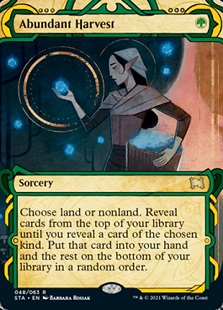 caveat that it's only legal in one constructed format. Talk about a risky marketing move. As an early preview that can be played, what happens if it proves too good before it's even released? Or worse, not good enough? The former would make players dread the set; the latter would turn them off. It's a very fine line, and I'm not sure how it is playing out.
caveat that it's only legal in one constructed format. Talk about a risky marketing move. As an early preview that can be played, what happens if it proves too good before it's even released? Or worse, not good enough? The former would make players dread the set; the latter would turn them off. It's a very fine line, and I'm not sure how it is playing out.
As for the card itself, Harvest is an effect Modern's seen before, but not in green. There's a long line of this effect in black, stretching back to Demonic Consultation. The closest comparison in Modern is Spoils of the Vault. Harvest is neither as powerful nor as risky as Spoils. Both cost one mana, but Spoils finds a specific card or no card to set up Thassa's Oracle. Alternatively, it kills its caster. Harvest asks if its caster wants a land or nonland, then gives them the first chosen type it finds. Straightforward and without risk. Green has had a number of cards in the vein of revealing cards to find a certain type, but they're usually limited to creatures or lands and look five cards deep at most. Harvest is anywhere from one card to the entire deck. And finds any nonland, potentially. Ancient Stirrings is eating its heart out.
Using Harvest
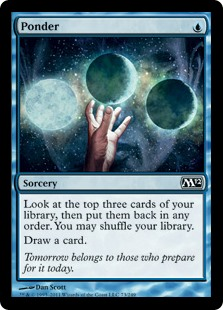 I've heard this called a card selection spell rather than a cantrip; it is both neither and both. It's only selection in that the caster chooses whether they want a land or a nonland. After that, they take the first instance revealed. The picked card being random doesn't really mean card selection to me. There's no choosing among options or setting up draws like Ponder or Oath of Nissa. It doesn't have a desirable effect and then replace itself, like Veil of Summer or Remand. It's not a tutor because the card is random. Thus it's not some freeroll card; players need to want to dig for a land or nonland to run Harvest.
I've heard this called a card selection spell rather than a cantrip; it is both neither and both. It's only selection in that the caster chooses whether they want a land or a nonland. After that, they take the first instance revealed. The picked card being random doesn't really mean card selection to me. There's no choosing among options or setting up draws like Ponder or Oath of Nissa. It doesn't have a desirable effect and then replace itself, like Veil of Summer or Remand. It's not a tutor because the card is random. Thus it's not some freeroll card; players need to want to dig for a land or nonland to run Harvest.
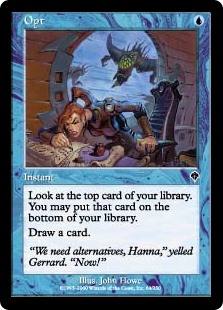 The single most powerful usage, and where I think a lot of players are leaning towards, is using Harvest to guarantee land drops. A one-land hand with a cantrip is better than one with no cantrip, but it's still a risky keep. Replace that Opt or Serum Visions with Harvest, and this risky keep becomes a snap-keep. Theoretically. So long as Harvest resolves and you name land, you will make your next land drop. Will it be an optimal land? Who knows. But it will be a land, and that's most important. For most decks, this is no problem; one land is as good as another. In decks that require specific lands, lack of choice may be a problem. As such, I suspect that many players will try to Turbo Xerox their decks with Harvest. More on that shortly.
The single most powerful usage, and where I think a lot of players are leaning towards, is using Harvest to guarantee land drops. A one-land hand with a cantrip is better than one with no cantrip, but it's still a risky keep. Replace that Opt or Serum Visions with Harvest, and this risky keep becomes a snap-keep. Theoretically. So long as Harvest resolves and you name land, you will make your next land drop. Will it be an optimal land? Who knows. But it will be a land, and that's most important. For most decks, this is no problem; one land is as good as another. In decks that require specific lands, lack of choice may be a problem. As such, I suspect that many players will try to Turbo Xerox their decks with Harvest. More on that shortly.
Finding nonlands is a vital but significantly less potent feature. Harvest does find all spells, which is good when flooding or otherwise out of gas. But again, there's no control over what spell is found. It might be useful, and it might be effectively blank. Stirrings and Oath give a choice of options so you get the most relevant spell, if any are present. A guaranteed spell is always good and deckbuilding can mitigate risk of a bad pull, but it is important to remember that Harvest finds a random spell where current cantrips give players choices.
Exploiting Harvest
Worth noting, Harvest is exploitable. The obvious way is naming nonland in a primarily land 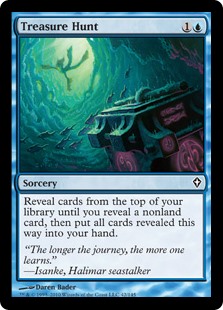 deck. Which means that Zombie Hunt moves ever-so-incrementally towards viability. I realize that the whole point of the deck is its cheapness, but by adding green and Harvest, Hunt won't have to mulligan so aggressively for Treasure Hunt. Instead, it can stop with a Harvest in hand, confidant that it will find either Hunt or Zombie Infestation. I will bet anything that the memelords will instigate a resurgence of the deck at minimum.
deck. Which means that Zombie Hunt moves ever-so-incrementally towards viability. I realize that the whole point of the deck is its cheapness, but by adding green and Harvest, Hunt won't have to mulligan so aggressively for Treasure Hunt. Instead, it can stop with a Harvest in hand, confidant that it will find either Hunt or Zombie Infestation. I will bet anything that the memelords will instigate a resurgence of the deck at minimum.
While potentially also useful for finding a land in Oops, All Spells, I don't know why anyone would bother. Seriously, given the MDFCs, why would anyone bother running one land and Harvesting for it? If Harvest let players stack their deck, that'd be one thing, but it doesn't. Therefore I don't see how it's possible to use Harvest naming land for a nefarious purpose which is better than existing options. Pay attention to that phrase, it will come back later.
A Warning From Historic
Everything I've said so far is great in a vacuum, but Abundant Harvest is not a card in a vacuum. Historic players have had just under a month to tune, test, and win with Harvest. They've already done the work, so now it's time to learn from them. And... I'm not entirely sure what I expected (again, I don't understand Historic), but it definitely isn't what's happening. At time of writing, Harvest is not a very popular card in Historic. It isn't even in the top 10 played cards from Strixhaven. And while the usual excuses of "Historic isn't Modern" in either cardpool or metagame are certainly applicable, they're not persuasive. Historic indicates that Harvest will not behave as expected in Modern, and might not even be played.
Those Who Ignore Historic...
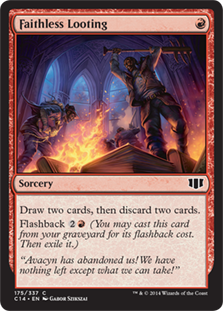 As alluded to above, the expectation was that Harvest's guaranteed land would lead to players aggressively cutting lands. This has not happened in Historic. I don't know why precisely, but even high-cantrip, low curve decks play 20 lands minimum, and most decks play upwards of 23. I suspect this is because a lack of fetchlands requires decks to play more lands to meet their color requirements. Mana curves are generally higher than Modern's, but not so much so to explain the higher land counts. And remember, this is a format with Brainstorm and Faithless Looting. If aggressive land-cutting was viable, it would be happening.
As alluded to above, the expectation was that Harvest's guaranteed land would lead to players aggressively cutting lands. This has not happened in Historic. I don't know why precisely, but even high-cantrip, low curve decks play 20 lands minimum, and most decks play upwards of 23. I suspect this is because a lack of fetchlands requires decks to play more lands to meet their color requirements. Mana curves are generally higher than Modern's, but not so much so to explain the higher land counts. And remember, this is a format with Brainstorm and Faithless Looting. If aggressive land-cutting was viable, it would be happening.
The second unexpected discovery was that Harvest doesn't see play in aggressive decks. The most common deck I see run Harvest is UB Mill Rogues, which is a slower tempo deck, similar to mono-Blue Tempo from a pervious Standard. Rogues can win fast, but its main plan is to ride a single threat for many turns and grind the opponent out. This strategy doesn't usually work in Modern. Behind Rogues are GRx decks, split between Gruul Beatdown and Jund Sacrifice. 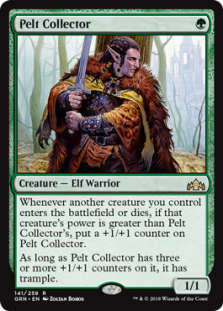 Jund is decidedly midrange while Gruul is on the slower side of aggro, more like stompy than a truly aggressive deck. I thought that Harvest's natural home would be Legacy-style cantrip beatdown, and while players have tried to make those decks work, the data indicates that they just don't.
Jund is decidedly midrange while Gruul is on the slower side of aggro, more like stompy than a truly aggressive deck. I thought that Harvest's natural home would be Legacy-style cantrip beatdown, and while players have tried to make those decks work, the data indicates that they just don't.
My third observation is that Harvest doesn't see much play in the decks interested in specific cards. This makes sense, as again Harvest finds a random card. However, this applies more generally than I expected. Based on limited experience watching streams, the value of Harvest isn't actually finding lands early but mitigating midgame flood. The decks that play Harvest have high land counts, and don't need to use Harvest to save sketchy hands. Instead, they struggle with their higher counts on later turns and there's no better card for pushing through a string of lands than Harvest. A problem that Modern players are quite familiar with.
...Are Doomed to Repeat It
In light of Historic's experiment with Abundant Harvest, I have strong doubts about its Turbo Xerox value. Historic has more and more powerful cantrips than Modern, and Harvest isn't very successful in cantrip heavy lists. Even as a way to push past 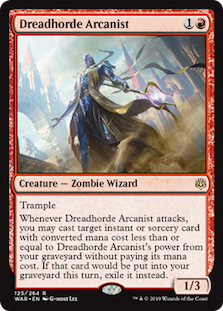 Brainstormed cards. I'm certain that players will try anyway, but if Historic Dreadhorde Arcanist lists don't always run Harvest in a format which is more amenable to it, how much success can it expect in Modern? Especially when it sees little play already?
Brainstormed cards. I'm certain that players will try anyway, but if Historic Dreadhorde Arcanist lists don't always run Harvest in a format which is more amenable to it, how much success can it expect in Modern? Especially when it sees little play already?
Outside of aggressive decks, there are slower decks that might enjoy midgame flood protection in Modern. Thus, they might use Harvest similarly to Jund Sacrifice. Outside of that, I'm not sure. Tron wouldn't give up Stirrings, the selection is too potent. Amulet Titan cut Stirrings a long time ago and I can't imagine it needs a more random version. Valakut decks, particularly Titan Shift, might want Harvest as a way to dig towards payoff cards, but I can't imagine they want to sacrifice their ramp cards to make space. Harvest presents more of a deckbuilding challenge than a clear tool. Which is a relief. I worried that Harvest would be an auto-include card.
The Main Problem
Additionally and relatedly, let's say that players make Harvest and/or Arcanist work as a Modern deck. How would such a deck be better than Prowess? Any Turbo Xerox-style deck will necessarily be playing in similar design space, and the decks will have significant overlap. However, an Arcanist deck will necessarily be slower than Prowess because the whole point is value acquisition, and  that doesn't happen at Prowess speeds. I can hear stalwarts arguing that Arcanist generates more prowess triggers, but A) it's not like Prowess decks need more of those and B) they could already do that, but don't. Which speaks volumes.
that doesn't happen at Prowess speeds. I can hear stalwarts arguing that Arcanist generates more prowess triggers, but A) it's not like Prowess decks need more of those and B) they could already do that, but don't. Which speaks volumes.
The question that Harvest will have to answer is how, in a format as fast and tempo-driven as Modern, is it worth a deck's time to durdle in the midgame? Right now it's not, so Harvest must make a very convincing case. Outside of Tron, Storm, and Izzet Prowess, decks don't bother with large numbers of cantrips because they can't take time off from playing to the battlefield. And even in those few cantrip heavy decks, they're intrinsic to the gameplan in a mana neutral or better way. Tron's jewelry makes mana, Storm and Prowess' cantrips generate storm count and damage. A (not free) cantrip for cantripping's sake just doesn't fit with Modern's style and makes me question whether Harvest can make a home in Modern.
Experiment By Doing
However, there's only one way to find out. I'm sure that players have already tested Harvest extensively and can say with more certainty than I if it passes muster. Plus, this week marks the start of official MH2 spoilers, so maybe there's more cards that will help Harvest fit in Modern. We all just have to see.





